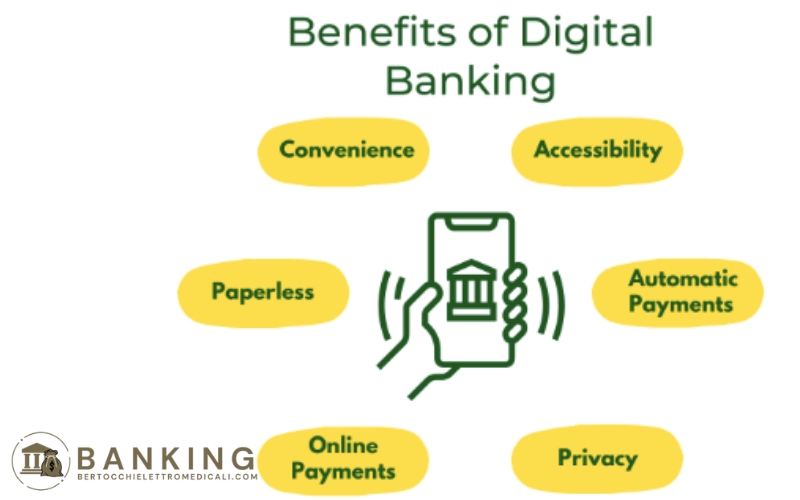Digital banking not only helps simplify financial transactions but also brings many outstanding benefits, from convenience to cost savings. This article will explore in detail about digital banking and the new benefits it brings.
WHAT IS DIGITAL BANKING?
Digital banking, also known as online banking, is a bank that operates entirely on an electronic platform, without a physical transaction branch. Instead of having to go to the bank to perform transactions such as money transfers, bill payments, account opening, and loans, customers can perform all these transactions through the bank’s mobile application or website. With digital banking, all financial activities become easier, faster and more convenient than ever.
Digital banking not only serves individuals but also supports businesses in optimizing financial processes, minimizing paperwork, helping to save costs and time significantly. The use of digital banking services is becoming more and more popular thanks to the development of technology and the increase in customer demand.

BENEFITS OF DIGITAL BANKING
The transition from traditional banking to digital banking brings many benefits not only to users but also to financial institutions. Below are the outstanding benefits that digital banking brings.
1. CONVENIENCE AND EASY ACCESS
Digital banking brings outstanding convenience compared to traditional banks. Users can make financial transactions anytime and anywhere with just an internet connection. You don’t have to waste time queuing at the bank or following branch hours. Opening an account, transferring money, paying bills, or even taking out a loan can all be done quickly through the bank’s mobile app or website.
This is especially useful in an increasingly busy society and the increasing demand for quick financial processing from consumers.
2. COST SAVINGS
One of the great benefits of digital banking is the ability to reduce operating costs for financial institutions. Digital banks do not have to maintain branches and tellers like traditional banks, thereby reducing operating costs. Therefore, customers will benefit from reduced service fees, free transfers, or can receive attractive promotions.
In addition, digital banking also helps users save time and effort, because there is no need to travel to branches or transaction points, thereby minimizing operating costs for users.
3. HIGH SAFETY AND SECURITY
An important issue when using digital banking is the safety and security of financial transactions. However, digital banks today have applied advanced security technologies such as data encryption, two-factor authentication (2FA), OTP (One Time Password) codes to protect customers’ account information. This helps prevent fraud risks and ensures that transactions are always carried out safely.
Digital banks also regularly update their security systems to deal with increasingly sophisticated threats from cybercriminals. Thanks to that, customers can rest assured when making online financial transactions.
4. 24/7 CUSTOMER SERVICE
Digital bank customers can access customer support services anytime, anywhere through online channels such as live chat, email, or call centers. This helps to quickly resolve any questions or problems that arise without the interruptions of traditional bank branches.
In addition, digital banks also provide automated services such as sending transaction notifications and electronic statements, helping customers track their financial activities conveniently and effectively.
5. NEW CONVENIENT SERVICES
Digital banks not only provide basic financial services but also bring many new convenient services, meeting the diverse needs of customers. For example, some digital banks provide personal financial management services, spending plans, or accumulate reward points for transactions. This helps users to clearly monitor their financial situation and easily make reasonable financial decisions.
In addition, digital banks also provide diverse financial products such as online loans, online insurance, or online stock investment, expanding many financial opportunities for users.
6. CONTINUOUS INNOVATION
Digital banks have the ability to innovate and update technology quickly, helping customers always experience the most modern services and latest utilities. Digital banks are constantly improving their applications and transaction systems, providing new features such as contactless transactions, QR code payments, or e-wallet integration.
This continuous innovation helps digital banks maintain their competitiveness in the financial industry, while providing customers with superior financial service experiences.
7. EXPANDING ACCESS TO BANKING FOR EVERYONE
Digital bankings makes financial services more accessible to everyone, including those who do not have access to traditional banks. Thanks to the ability to use on mobile devices and the internet, digital bankings helps people in remote areas to participate in the financial system without having to go to bank branches.
This helps increase the coverage of financial services and creates opportunities for more people and businesses to access financial resources.
CONCLUSION
Digital bankings is not only a new trend in the financial industry but also brings practical benefits to consumers. From convenience, low cost, high security to convenient services and constant innovation, digital banking is changing the way we manage our finances and conduct banking transactions. With the development of technology and the increasing demand for online financial services, digital banking will certainly continue to develop and play an important role in the global financial system.
